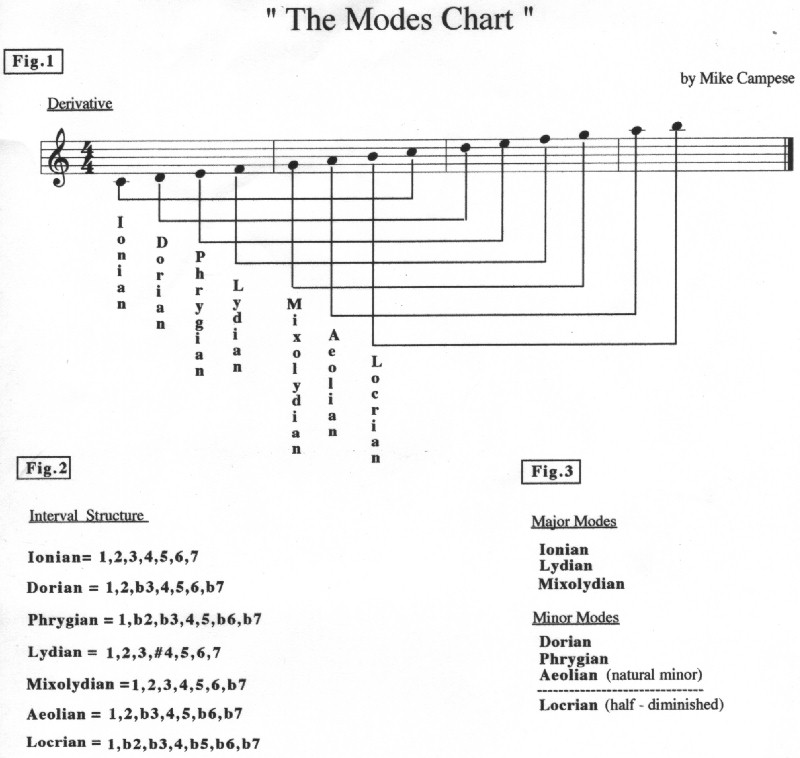Hello everyone! Happy international guitar month! It's great to be back. We are going to talk about the Modes in this lesson. I hope to clear up some confusion you might have about them. I've been a instructor for many years and have been teaching the modes for a long time. Many guitarists make a effort to use them. I use them in my music too. So for the first part of this lesson I'll explain what the Modes are, their names, and how they are built. In the next lesson we will focus more on putting them to use. Also, you will want to hang the Modes chart I put together on the wall of your practice area. You will want to memorize all this information to be able to use the Modes properly. Let's do it...
Modes is another name for the scales formed from the Major scale (Parent scale). You can form a mode by playing a Major Scale and starting from different notes in the scale. For example, say we begin with a C major scale (C, D, E, F, G, A, B). So C is our root. If we play the same notes from D to D, and make D the root, it becomes a D Dorian scale. Still using the same notes, if we start with the 3rd note E, then we will have a E Phrygian scale. In Figure 1 you will see seven different modes in order. created from the Major scale. Seeing all the Modes derived from one parent scale is called Derivative. This works the same way in all keys. Make sure you memorize the names and their order.
If you look at Figure 4, I notated the seven modes in C for you. You should play these scales in different positions. I put the chords above each scale so you know which chord relates to each mode. So for example, learn that Mixolydian is built from the 5th step of a major scale and the mode comes from the chord G7. Make sure you know all the Modes in this fashion. Also, be aware of the notes you are playing and memorize each shape so you can move it around to different keys.
I hope you're still with me. If not, go back and read it again until you understand it.
It's very important to learn the Modes in parallel, which means comparing them with one another beginning on the same root note. So C Ionian is compared to C Dorian, C Phrygian, etc. Figure 2 shows the interval structure for all 7 Modes. Memorize these cold and build these scales off all roots. If you look at Figure 5 you will see all the modes in C as two octave shapes in the parallel approach. Don't forget to be aware of the notes in each scale as you play them. You can play these in any position also. You will notice each mode has its own unique flavor.



Look at Figure 3. We have 2 catagories: Major and Minor. Ionian, Lydian and Mixolydian are Major Modes. Dorian, Phrygian and Aeolian are Minor Modes. Locrian is the odd one with its half-diminished quality. It's easy to apply them by knowing this. You must memorize the chords in each key. For example, in C they are C, Dm, Em, F, G, Am and Bdim. In a Major key it's always Maj, min, min, Maj, Maj, min, diminished. If you use 7th chords it is: Maj7, min7, min7, Maj7, Dom7, min7, min7(b5).
When you first learn the Modes you should record yourself vamping on each chord for a while, then play back the tape so you can play each scale over each chord to hear the flavor of each Mode. Make sure you return to the root frequently to maintain the Mode's flavor. So over a C major chord you will play C Ionian; over Cmin you will play C Dorian, etc. If you have a song in a major tonality you can use any of the 3 major Modes. Or, if you are in a minor tonality, you can use any of the 3 minor Modes.
It sounds cool to mix the Modes together, but you will have to use your ear on this one. If you are using power chords it's easier to mix them because the 3rd of the chord is omitted. Sometimes I like to keep a drone note ringing when I use them. I might let a E note ring and play a Mode over it, like E Lydian; this really brings the sound of the mode out. A cool rock approach is to play power chords off each note of the Mode you are using. Make sure you return to the root often. The goal is to get the sound of each Mode in your ears.
OK, this wraps up our lesson. Work with these Modes and you will begin to see how useful they are and how different each one sounds. If you have any questions feel free to email me. Be sure to check out my CDs on this amazing site and look for a new CD release soon. Visit mikecampese.com for more information.
Mike Campese is an all-around music performer, session artist and teacher competent in many musical styles, electric and acoustic. He has studied at G.I.T. (Honors Graduate), and with Paul Gilbert, Norman Brown, Stanley Jordan, Scott Henderson and Keith Wyatt.